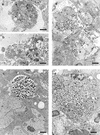Kinetics of infection and effects on placental cell populations in a murine model of Chlamydia psittaci-induced abortion
- PMID: 9573099
- PMCID: PMC108173
- DOI: 10.1128/IAI.66.5.2128-2134.1998
Kinetics of infection and effects on placental cell populations in a murine model of Chlamydia psittaci-induced abortion
Abstract
The anatomical progression of chlamydial infection was studied in different areas of the placenta, using a mouse model and two inoculation times: early pregnancy (day 7, group A) and midpregnancy (day 11, group B). The first population cells affected were decidual cells and neutrophils located just at the limits of the maternal and fetal placenta. The following invaded area was the layer of giant cells. Complete colonization of the maternal placenta occurred after day 15 of pregnancy independently of the inoculation time, the metrial gland being the last area to be invaded; numerous granulated metrial gland (GMG) cells were infected. Finally, chlamydial inclusions were observed in labyrinthine trophoblastic cells from day 18 of pregnancy onward. Since no fetal damage was observed, it seems that an indirect mechanism involving the lysis of GMG cells and neutrophil infiltration of the decidua and metrial gland may be the pathogenic mechanism that leads to abortion.
Figures



References
-
- Abzug M J, Rotbart H A, Magliato S A, Levin M J. Evolution of the placental barrier to fetal infection by murine enteroviruses. J Infect Dis. 1991;163:1336–1341. - PubMed
-
- Awan A R, Baxi M, Field H J. EHV-1-induced abortion in mice and its relationship to stage of gestation. Res Vet Sci. 1995;59:139–145. - PubMed
Publication types
MeSH terms
LinkOut - more resources
Full Text Sources

